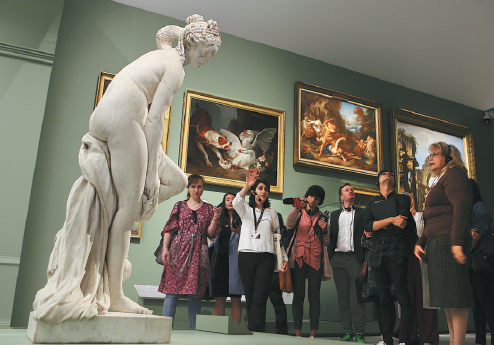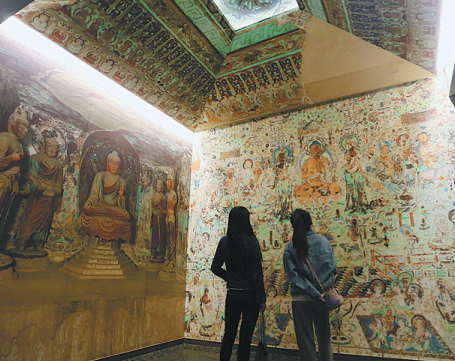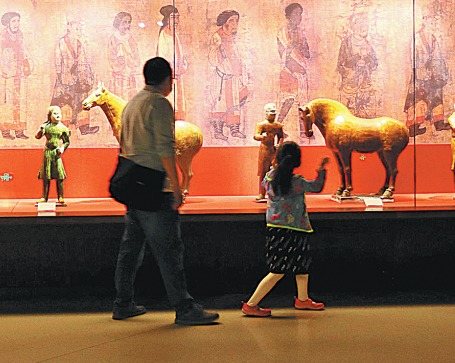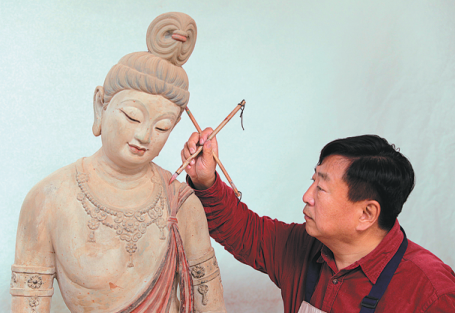Cultural connections gain fresh life

With touring exhibitions, museums play role in deepening mutual understanding
Editor's note: People-to-people exchanges are deepening the connections between countries participating in the Belt and Road Initiative. This column celebrates the efforts of those working toward a shared future.
When Maryam Mohsin Hassan Abdalla visited Gansu Provincial Museum in 2016, she was impressed by its exotic charm and mixture of Eastern and Western cultures.
The 23-year-old Sudanese, from Khartoum, recalls she was enchanted by a series of exhibitions at the museum in Lanzhou, in China's Northwest. These included the Silk Road Exhibition and the Buddhist Art of Gansu. Also catching her eye was the famous bronze sculpture Galloping Horse Treading on a Flying Swallow.
"Gansu struck me as a special place where Chinese culture interacted with the Western culture," she says of the province's location on the ancient Silk Road. "Its cultural relics also demonstrated a diversity of cultures, including Muslim culture and Arabic cultures. I was also impressed by the magnificence of the Mogao Grottoes of Dunhuang, which helped me learn more about Buddhism."
Abdalla is far from alone in valuing the learning experience to be gained from museums.
President Xi Jinping, in an address to the 20th meeting of the Council of Heads of State of the Shanghai Cooperation Organization, called for the world to nourish people-to-people amity and build a community of cultural exchanges for us all.
"Each civilization is distinct and none is superior to others. We need to promote mutual learning between our civilizations and enhance good-neighborliness and friendship between our countries," he said via video in November last year.
Museums of countries involved in the China-proposed Belt and Road Initiative, or BRI, have increased the frequency of exhibitions on the cultural relics of other participating nations since the initiative was unveiled in 2013, museum insiders say. In doing, so they have strengthened people-to-people exchanges and mutual understanding.
The BRI focuses on promoting policy coordination, connectivity of infrastructure and facilities, unimpeded trade, financial integration, and closer people-to-people ties through extensive consultation, joint contributions, and shared gains, with the goal of bringing benefits to all.
Manuel Rabate, director of Louvre Abu Dhabi in the United Arab Emirates, says the museum has a number of important Chinese works in its collection, including the Winged Dragon, a sculpture from the Chinese Warring States Period (475-221 BC).
"Our dragon is actually a hybrid made up of various animals, with the hindquarters of a feline, the forequarters of an alligator, the antlers of a stag and the wings of a bird," he says. "It is also one of the largest free-standing sculptures of a dragon known to date in Chinese art. It is extremely popular with our audiences and we often see visitors taking selfies with it."
Rabate says that cultural exchange is a critical factor in the success of humanity and it is Louvre Abu Dhabi's main mission to tell stories of cultural connections.
He says the museum benefits from the UAE's unique position at the crossroads of East and West and that the country maintains strong historical and contemporary links with China. This contributes to a strong relationship with China, he says.
"We share a known history of mutual trade and commerce dating back over a thousand years and indeed several of the displays in our permanent galleries look at cultural and artistic exchanges along the Silk Road, for example," Rabate says.
He says Chinese visitors have always been very important and the museum has a Mandarin-speaking guide on the staff. Before the pandemic, China was the top source of the museum's visitors, with Chinese making up 9.4 percent of them in 2019.
Rabate says the museum's next international exhibition will look at eight centuries of artistic and cultural exchanges between China and the Islamic world.
"I'm looking forward to how it will spotlight the many existing cultural and artistic exchanges between our home region and China," he says.
Xu He, the project leader of the International Liaison Office of Art Exhibitions China, says that in the years before the pandemic forced the closure of borders, the organization had brought an increasing number of art exhibits to audiences in countries involved in the BRI. In 2014, the exhibition Treasures of China was held in Tanzania and, in the following year, the center curated exhibitions on China's general history in Latvia, Lithuania and Cyprus.
In 2016, the Treasures of China exhibition was taken to the Museum of Islamic Art in Qatar, bringing China's Terracotta Warriors to people in the Gulf state for the first time. Over 70,000 visitors flocked to the exhibition in three months, and children created clay sculptures based on the warriors in workshops after seeing the exhibition.
Xu says that, in planning for exhibitions in BRI countries, it is essential that curators bring over cultural relics with elements that local audiences will be familiar with, or connect with in some other way. In this spirit, she chose some plates with Arabic characters for the exhibition in Qatar. For Southeast Asia, it was the ornamentation art from Beijing's Summer Palace that people could relate to, as they understand more about Chinese culture.
"At present, the exhibitions we have held in the BRI countries are mostly focusing on China's iconic cultural exhibits and about general history to help the local audience gain a basic understanding of Chinese culture," Xu says. "We would like to make more exhibitions that can deepen their understanding."
Xu says that Chinese audiences, in turn, have been increasingly interested in cultural relics and art from other BRI countries. For instance, the Splendor of Asia-An Exhibition of Asian Civilizations in 2019 in Beijing, showcasing 451 items of cultural relics from all 47 countries in Asia, including China, as well as the ancient civilizations of Greece and Egypt, proved a hit with Chinese audiences.
In a similar vein, cultural relics from Afghanistan that were put on tour in China for two years from 2017 made an impact. When they were exhibited in the Forbidden City, more than 8,000 visitors came each day.
"We have a splendid plan of curating a series of exhibitions of cultural relics and artworks that Chinese audience are not quite familiar with from BRI countries, including Pakistan, Iran, and Iraq," says Xu, adding that the first exhibition from Syria will kick off a two-year tour from June, starting from Shenzhen in the south.
Xu says that while the COVID-19 pandemic has halted cross-border exhibitions over the past year, other factors have in the past brought their own difficulties, such as transportation, financing, and exhibits' vulnerabilities. "I think that in the post-pandemic era, there will be more cultural relics exhibitions from BRI countries in China, as Chinese audiences' demand for such exhibitions is getting stronger," she says.
In 2016, more than 30 museums from countries participating in the BRI formed an alliance under which they signed agreements on the protection and exchange of cultural relics, along with efforts to promote mutual learning among civilizations and cultural coexistence.
Han Bing, the chief researcher of culture and entertainment practice of global consultancy Roland Berger, says cultural exchanges help people in BRI countries to understand each other.
"Museums are important carriers of culture and history, and every exhibit tells a story," she says. "Cultural relics selected for exhibition should represent a country's unique culture and history and the values of openness and inclusiveness of the BRI."
She says the staging of cultural exhibitions can also help BRI nations exchange experiences on the operation and management of museums, taking in business models, fundraising and management systems. Such shared knowledge can improve the management efficiency of these museums.
Yang Ran and Wang Kaihao contributed to this story.
chenyingqun@chinadaily.com.cn


























